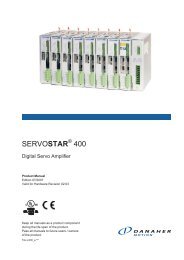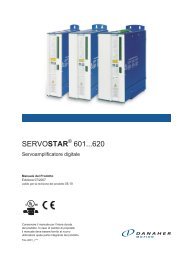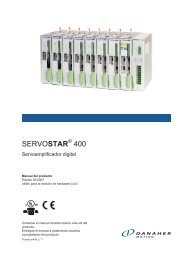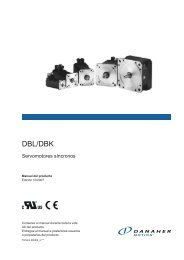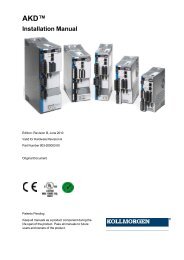SERVOSTAR™ 300
SERVOSTAR™ 300
SERVOSTAR™ 300
Create successful ePaper yourself
Turn your PDF publications into a flip-book with our unique Google optimized e-Paper software.
Technical description 07/2010 Kollmorgen<br />
6.8.2 Emergency Stop: Standards<br />
The emergency Stop function is used for the fastest possible shut-down of the machine<br />
in a dangerous situation. The Emergency Stop function can be triggered by the actions of<br />
a single person. It must be fully functional and available at all times. The user must not<br />
have to work out how to operate this mechanism.<br />
The Emergency Stop function is defined by IEC 60204.<br />
In addition to the requirements for Stop, the emergency Stop must fulfil the following<br />
requirements:<br />
� emergency stop must have priority over all other functions and controls in all operating<br />
situations;<br />
� the energy supply to any drive machinery that could cause dangerous situations<br />
must be switched off as fast as possible, without causing any further hazards (e.g. by<br />
using mechanical latching devices that do not require an external supply of energy,<br />
by counter-current braking in Stop Category 1);<br />
� the reset must not initiate a restart.<br />
If necessary, provision must be made for the additional connection of emergency stop<br />
devices (see IEC 60204, "Requirements for emergency stop devices"). The Emergency<br />
Stop must be effective as a stop of either Category 0 or Category 1.<br />
The Emergency Stop Category must be determined by a risk evaluation of the machine.<br />
Category 0<br />
Only hard-wired, electromechanical components may be used for the Category 0 Emergency<br />
Stop function. It must not be triggered using switching logic (hardware or software),<br />
by transferring commands via a communication network, or via a data link.<br />
The drive must be shut down using an electromechanical circuit. If the connected servo<br />
motor has an integrated brake, this must always be controlled by an electromechanical<br />
circuit as well.<br />
Category 1<br />
With the Category 1 Emergency Stop function, there must be absolute certainty in terms<br />
of the power supply for the machine drives being switched off (i.e., secured) using electromechanical<br />
components. Additional Emergency Stop equipment may be connected.<br />
Bringing the motor to a standstill by interrupting the mains supply and using controlled<br />
electronic braking. The 24 V supply for the servo amplifier must remain constant. The<br />
issue of which circuit should be used is highly dependent on the requirements of the<br />
application at hand.<br />
In most servo motors a brake has only the function of a holding brake. To ensure an<br />
emergency stop function, the braking torque that is required must be checked. If the holding<br />
brake fulfills the dynamic requirements, it must be taken into acount that this application<br />
will cause increased wear.<br />
Examples for implementation can be found in the Product WIKI on page "Stop and<br />
Emergency Stop Function".<br />
34 SERVOSTAR <strong>300</strong> Instructions Manual




